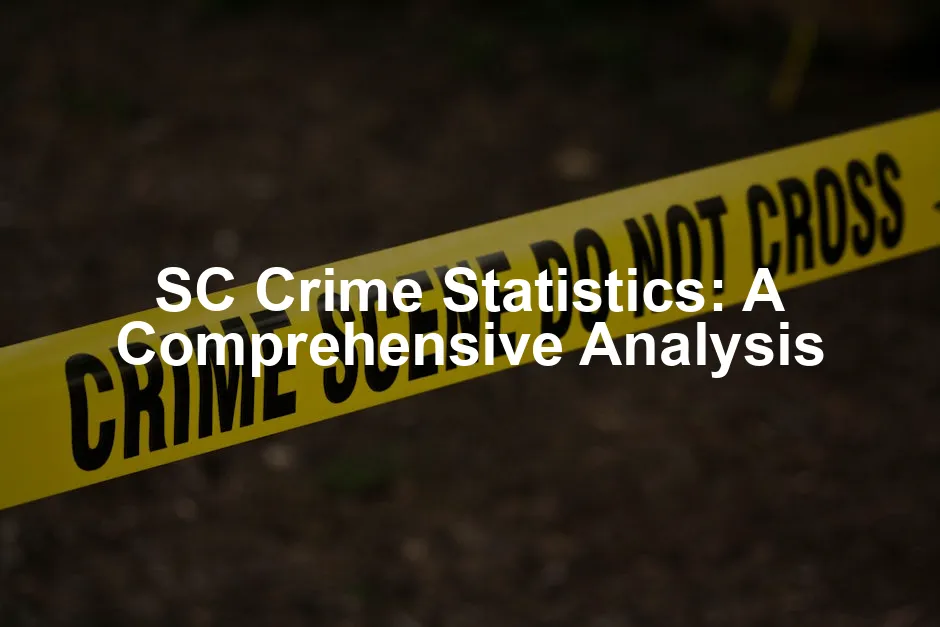Introduction
Crime statistics play a crucial role in shaping our understanding of public safety in South Carolina. They help us grasp the effectiveness of law enforcement and the ongoing struggles communities face. With crime data at our fingertips, we can hold policymakers accountable and advocate for safer neighborhoods.
Accurate crime data is essential for various stakeholders. Policymakers rely on it to craft informed legislation. Law enforcement agencies use these statistics to allocate resources effectively. Citizens benefit by understanding local crime trends, which can inform personal safety decisions. When communities engage with these numbers, they become empowered to push for positive change.
If you’re looking for a gripping read that dives deep into the human psyche behind crime, look no further than Crime and Punishment by Fyodor Dostoevsky. This classic novel explores the moral dilemmas and psychological turmoil of its characters, making it a must-read for anyone interested in the darker aspects of human nature.
In this article, readers can expect to learn about the latest crime statistics in South Carolina. We will break down trends over the years and compare data with national averages. Additionally, we will provide valuable resources for accessing crime information and understanding the implications of these statistics. By the end, you’ll have a comprehensive view of crime in South Carolina and what it means for you.

Understanding Crime Statistics
What are Crime Statistics?
Crime statistics refer to the data collected on criminal offenses reported to law enforcement agencies. These statistics serve as essential tools for evaluating law enforcement’s performance and public safety. Law enforcement utilizes these statistics for strategic decision-making and resource allocation.
Crime is typically categorized into two main types: violent and property crimes. Violent crimes include offenses such as murder, sexual assault, robbery, and aggravated assault. These crimes directly harm individuals and often instill fear in communities. Property crimes, on the other hand, encompass burglary, theft, and motor vehicle theft. While they may not result in physical harm, they affect the sense of security within a community.
For those fascinated by crime narratives, The Crime Book: Big Ideas Simply Explained is a great choice. It breaks down complex ideas into digestible insights, making crime theories accessible to everyone.
Understanding the distinctions between these crime types helps citizens grasp their local safety landscape. By examining crime statistics, we can identify patterns and trends that may require attention, leading to informed discussions about community safety initiatives and law enforcement practices.

Overview of Reporting Systems
SLED and UCR
The South Carolina Law Enforcement Division, or SLED, plays a pivotal role in crime reporting and statistics. Established to enhance public safety, SLED administers the Uniform Crime Reporting (UCR) program. Since its inception in 1930, UCR has compiled crime data from law enforcement agencies nationwide. This system allows for standardized reporting, ensuring that crime statistics are comparable across different jurisdictions.
In South Carolina, law enforcement agencies submit their crime data to SLED, which then aggregates it for statewide analysis. This process not only helps understand local crime trends but also feeds into national databases, allowing for broader insights into crime across the country. With SLED’s oversight, residents of South Carolina can access reliable and accurate crime statistics, making it easier to stay informed and safe.
If you’re curious about the societal impacts of incarceration, you might want to check out The New Jim Crow: Mass Incarceration in the Age of Colorblindness by Michelle Alexander. This eye-opening book delves into the racial and social implications of mass incarceration in America, making it a crucial read for understanding systemic issues.
SCIBRS
The Incident-Based Reporting System (SCIBRS) is another critical component of crime data collection in South Carolina. Unlike traditional summary reporting systems, SCIBRS provides detailed information on each incident. This incident-based method captures specifics such as the nature of the crime, victim details, and offender demographics.
SCIBRS is significant because it offers a more nuanced view of crime. It allows law enforcement and policymakers to identify patterns, understand the context of crimes, and develop targeted interventions. The depth of data collected through SCIBRS empowers communities and law enforcement alike, providing the necessary insights to tackle crime effectively.

How Crime Data is Collected and Reported
Crime data collection in South Carolina relies on a systematic approach. Law enforcement agencies across the state report incidents to SLED, which compiles this information into comprehensive databases. The data is collected through various means, including direct reporting from police departments and automated systems. This multifaceted approach ensures a comprehensive view of crime across the state.
Accuracy and transparency are paramount in crime reporting. When law enforcement agencies report data, they must adhere to strict guidelines to ensure that the information is both precise and reliable. Any discrepancies or inaccuracies can lead to misunderstandings about public safety and may affect resource allocation. Transparency in the reporting process builds trust within communities, allowing citizens to engage more effectively with law enforcement.
In summary, the methodologies used for crime data collection in South Carolina emphasize the importance of accuracy, transparency, and collaboration between law enforcement agencies and the community. By ensuring that data is collected and reported consistently, South Carolina can better address its crime challenges and enhance public safety.

Breakdown of Violent Crimes
– Murder: South Carolina’s murder rate sits at 0.11 per 1,000 residents. In 2022, there were 592 reported murders. Comparatively, the national average stands at 0.06. Charleston County claims the title of the highest murder rate, reporting 70 murders last year. This discrepancy raises eyebrows and reminds us that while sunny days may be plentiful, the shadows of crime linger.
– Sexual Assault: The sexual assault figures are alarming, with a rate of 0.38 per 1,000 residents in South Carolina. In total, 2,019 cases were reported in 2022. Compared to the national average of 0.40, South Carolina’s numbers indicate a slight variance, yet the issue remains serious. Trends show that awareness and reporting have increased, making it crucial for communities to continue supporting victims.
If you’re intrigued by true crime stories, consider picking up The Innocent Man: Murder and Injustice in a Small Town by John Grisham. This gripping tale of a man wrongfully convicted of murder sheds light on the flaws in the justice system and the human cost of legal errors.
– Robbery and Assault: Robbery rates in South Carolina are at 0.41 per 1,000 residents, with 2,145 incidents reported. Meanwhile, aggravated assaults dominate, with 21,199 cases logged, translating to a staggering 4.01 per 1,000 residents. The national average for assault is 2.68, so South Carolina is well above this threshold. Understanding these stats is vital; they’re not just numbers but stories waiting to be told.

Breakdown of Property Crimes
– Burglary: Property crimes total 121,935 statewide, with burglary accounting for 3.53 incidents per 1,000 residents. That’s 18,632 burglaries reported last year alone. The numbers tell us that while some neighborhoods shine, others are under the cloud of theft. Enhanced community vigilance can help turn the tide.
– Theft and Motor Vehicle Theft: Theft dominates the property crime landscape, with a jaw-dropping 90,137 incidents reported, yielding a rate of 17.06 per 1,000 residents. Motor vehicle theft adds another layer of concern, with 13,166 cases, or 2.49 per 1,000. Comparing these to national averages—14.02 for theft and 2.83 for vehicle theft—reveals that South Carolina’s property crime rates demand attention and action.

For those interested in the psychology of crime, Mindhunter: Inside the FBI’s Elite Serial Crime Unit by John E. Douglas is a fascinating exploration of criminal psychology and the methods used by the FBI to catch serial killers.
Factors Influencing Crime Rates
Socioeconomic Influences
Crime rates often reflect the socioeconomic fabric of a community. Poverty, education, and employment are key players in this drama. When folks struggle to make ends meet, crime can seem like a tempting shortcut. South Carolina has a poverty rate hovering around 13%, higher than the national average. This financial strain can lead to desperate actions.
Education is another crucial aspect. Areas with lower educational attainment tend to experience higher crime rates. When people lack access to quality education, opportunities diminish, pushing some toward crime as a means of survival. Raising educational standards can be a game changer. A well-educated populace is generally more engaged and less likely to resort to crime.
Employment plays a similar role. High unemployment rates often correlate with increased crime, as jobless individuals may feel they have few options. South Carolina’s economy has seen ups and downs, impacting job availability. When jobs are scarce, crime can spike.
Demographics also matter. Certain age groups, particularly young males, are more likely to commit crimes. Understanding these trends helps law enforcement and policymakers target interventions more effectively. In neighborhoods where youth programs flourish, crime tends to decline. It’s all about creating opportunities that keep young people positively engaged.

Law Enforcement and Policy Changes
Law enforcement policies have a direct impact on crime rates. Recent changes in South Carolina aim to improve community safety. For instance, SLED has implemented strategies focusing on community policing. This approach encourages officers to build relationships with residents, fostering trust. When community members feel connected to law enforcement, they are more likely to report crimes.
Moreover, the state has made strides in addressing systemic issues. Initiatives targeting drug-related offenses and gang violence have gained momentum. By focusing on root causes, law enforcement can tackle crime more effectively.
If you’re interested in how crime can be depicted in literature, True Crime: A Novel by Andrew E. Kaufman is a gripping tale that brings the chilling world of crime to life through fiction.

Community and Social Engagement
Community engagement is crucial in the fight against crime. When residents collaborate with local law enforcement, they become active participants in their safety. Programs that encourage citizen involvement, such as neighborhood watch groups, have shown promise. They foster a sense of community and responsibility.
Social services play a significant role too. Assistance programs that provide support for mental health, addiction, and housing can reduce crime. When individuals receive help, they are less likely to turn to criminal activities. Investing in social services creates a safety net that benefits everyone.
Moreover, community events can strengthen ties between residents. Festivals, clean-up days, and educational workshops encourage interaction. These gatherings not only build camaraderie but also create a collective sense of responsibility for neighborhood safety.
In summary, the interplay between socioeconomic factors, law enforcement policies, and community engagement shapes crime rates in South Carolina. By addressing these elements, we can work towards a safer future for all.

Accessing Crime Data
Curious about crime statistics in South Carolina? You’re in luck! The South Carolina Law Enforcement Division (SLED) provides a treasure trove of crime data. You can explore their crime statistics page here. SLED compiles crime reports from local law enforcement, giving you a clear picture of crime trends across the state.
Another fantastic resource is the South Carolina Incident-Based Reporting System (SCIBRS). This system offers detailed data on individual crime incidents. You can access SCIBRS here. To navigate these databases, start by selecting your desired year and type of crime. It’s a bit like shopping online—just with less cart abandonment!

If you’re interested in how crime stories are told through the lens of fiction, consider The Complete Sherlock Holmes by Arthur Conan Doyle. These classic detective stories offer a unique perspective on crime and investigation.
Visualization Tools
Want to visualize crime data in a way that even your grandma would understand? Check out the Theme Oriented Public Site (TOPS). This interactive platform allows users to analyze crime trends visually. From jurisdictions to years and categories, you can see how crime evolves over time. Access TOPS here.
Using TOPS can help you identify patterns and trends. It’s like having a crystal ball for crime data! Understanding these visuals can empower communities, leading to informed discussions about safety and prevention.

For those interested in crime data analysis, exploring the fremont crime statistics can provide additional insights into crime trends and safety measures.
Reporting Crime and Safety Resources
If you see something fishy, say something! Citizens can report crime through local law enforcement agencies. Each department has specific procedures for reporting incidents, which you can usually find on their websites. Remember, if it feels urgent, don’t hesitate to call 911!
For non-emergency situations, you can often reach out to local police departments directly. For instance, the Hardeeville Police Department can be contacted at 843-784-2233. Knowing how to report crime keeps communities engaged and safe.
Stay informed and connected with your local law enforcement. They’re there to help, and your involvement can make a difference. If you want to enhance your personal security, consider investing in a Home Security Camera System. It’s a great way to keep an eye on your property and deter potential crime.
Please let us know what you think about our content by leaving a comment down below!
Thank you for reading till here 🙂
All images from Pexels




